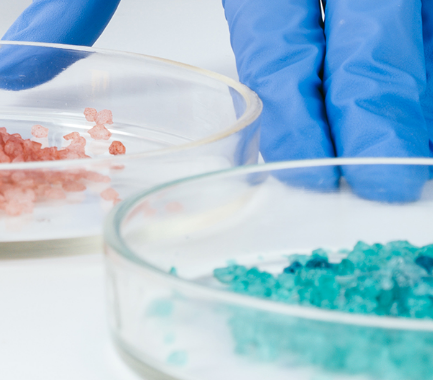Your contact
PENPET-Team - Hamburg

Laurens Rogowski
Sales
Tel. +49 (0) 40 - 675 7 99 80
sales@penpet.de
Get in touch with us.
Para-tertiary butyl benzoic acid (PTBBA)
Para-tertiary butyl benzoic acid (PTBBA) is an organic compound that belongs to the derivatives of benzoic acid and is mainly used in the manufacture of plastics. The substance is formed when liquid 4-tert-butyltoluene oxidizes in air. For large-scale production, optimized processes are used in which this reaction is promoted by a catalyst such as cobalt(II) acetate.
The carboxylic acid is used as an additive in polymer production to limit the molecular size of polyesters, to nucleate polypropylene and to improve the properties of alkyd resins. In addition, para-tertiary butyl benzoic acid is used as an extraction agent. Alkali salts and alkaline earth salts of the compound are used to stabilize polyvinyl chloride (PVC). Salts of para-tertiary butylbenzoic acid with amines are used as corrosion inhibitors and antioxidants for lubricants. The substance is also an important starting material for the chemical synthesis of various organic compounds.
At PENPET, you receive para-tertiary butylbenzoic acid of the highest quality - from a reliable partner who will also meet your requirements in the long term. We look forward to receiving your inquiry for an individual offer. The solid can be delivered punctually as a crystalline powder in sacks and Big Bags with different weights.
CAS no. 98-73-7
EINECS no. 202-696-3
Molecular formula: C11H14O2
Synonyms: 4-tert-butylbenzoic acid, para-tert-butylbenzoic acid, p-(tert-butyl)benzoic acid, 4-(1,1-dimethylethyl)benzoic acid, PTTBA, p-TBBA, TBBA
Areas of application: Starting material for organic syntheses, modifying additive for polymeric plastics, base material for antioxidants and anti-corrosion agents
More Information
As a butyl derivative of benzoic acid, para-tertiary butyl benzoic acid (PTBBA) consists of three components. The center of the compound is formed by a benzene ring. On the one hand, this is linked to a carboxyl group to form benzoic acid. On the other hand, the benzene ring has a branched tert-butyl group. The suffix "para" expresses the fact that these two groups are attached to two opposite carbon atoms of the benzene ring.
The substance therefore has two reactive sites: On the one hand, the benzene ring in the center of the structure has an unsaturated character and can, among other things, take up hydrogen atoms in addition reactions. On the other hand, para-tertiary butyl benzoic acid (PTBBA) has a functional group with the carboxyl group of benzoic acid, which can undergo esterification reactions with alcoholic compounds or form salts with metallic cations.
Para-tertiary butyl benzoic acid (PTBBA) is a white solid that is processed as a powder or in the form of crystalline flakes. The compound has a faint, slightly aromatic odor. It reaches its melting point at a temperature of over 160 °C and then goes into the liquid state. Para-tertiary butyl benzoic acid boils at 280 °C with thermal decomposition. The aqueous solution of the substance is acidic. The compound is hardly soluble under acidic conditions, but easily soluble in water at a neutral pH. In addition, the compound is readily soluble in many organic solvents such as benzene, acetone, chloroform, toluene, ethanol and methanol.
When stored as directed, para-tertiary butyl benzoic acid (PTBBA) is a chemically stable compound. Dangerous reactions of the substance can occur in contact with strong oxidizing agents and strong bases.
The compound is flammable, but is difficult to ignite. However, when processing open containers of the substance, finely whirled up particles of para-tertiary butyl benzoic acid can easily form flammable and explosive air-dust mixtures with the ambient air. The substance should therefore be kept away from possible ignition sources such as hot surfaces, open flames, sparks and electrical discharges. Combustion and thermal decomposition of the compound can release large amounts of harmful gases such as carbon dioxide and carbon monoxide.
Para-tertiary butyl benzoic acid (PTBBA) is considered a substance that poses acute and chronic health hazards. The relevant findings come from tolerance tests on animals. In the event of skin and eye contact with the compound, slight irritation and reddening, which are usually rapidly reversible, are to be expected. Affected parts of the body should be rinsed thoroughly with water and examined by a doctor if the symptoms persist.
There is a risk of severe poisoning from para-tertiary butyl benzoic acid if the compound is swallowed and then absorbed into the metabolism. In this case, impairments of the central nervous system, cardiovascular disorders and organ damage to the kidneys, liver and testicles can occur. Impaired fertility is possible. After accidental ingestion of para-tertiary butyl benzoic acid, the mouth should be rinsed out and the liquid, if possible, spit out immediately. A medical examination with subsequent medical monitoring of possible symptoms of poisoning must be arranged immediately.
The compound has been classified as a major aquatic hazard with respect to its likely harm to aquatic organisms, long-term effects on aquatic environments and as a major hazard to drinking water. It is therefore important to prevent para-tertiary butyl benzoic acid from entering the environment. If the substance escapes into the sewage system, into the ground or into water, the responsible authorities must be informed.
